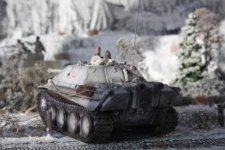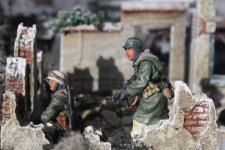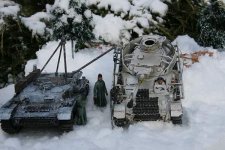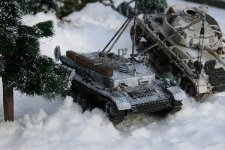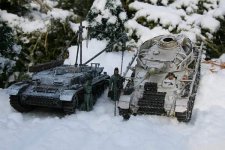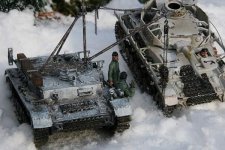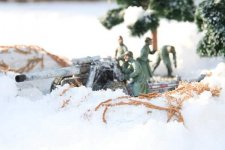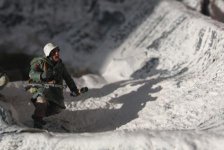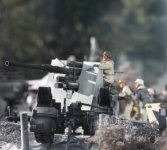You are using an out of date browser. It may not display this or other websites correctly.
You should upgrade or use an alternative browser.
You should upgrade or use an alternative browser.
Creating the Battle of the Bulge.....Wacht Am Rhine (2 Viewers)
- Thread starter panda1gen
- Start date
Iron Brigade
Command Sergeant Major
- Joined
- Jul 27, 2007
- Messages
- 2,135
The Lt and I were discussing some posts and he suggested a WW2 thread, here goes.
December 15th 1944, the german forces gather for a major push into W Europe - a desperate gamble to reach the sea at Antwep and split the allies, via the Meuse bridges around Liege. Hitler throws everything he can to the South of the recent fighting in the Hurtgen, recreating his daring attack of 1940, again against the advice of his generals, particularly Guderian, who worried more about the Russians on the border in the East.
At the tip of the scherpunkt in the North is Kampfegruppe Peiper. Two panzer 4 companies would lead followed by two panther companies and panzer grenadiers in half tracks. These would be followed by artillery and engineers whilst the Tiger 2 tanks of SS Panzer Abteilung 501 would bring up the rear. The forces concentrated in the tiny German and Belgian towns of the eastern Ardennes and the difficult terrain of the Schnee Eifel.
Dear "Panda1gen":
Really splendid photos and a great diorama!
"Iron Brigade"
panda1gen
Colonel
- Joined
- Jul 29, 2005
- Messages
- 8,154
Dear "Panda1gen":
Really splendid photos and a great diorama!
"Iron Brigade"
Thank you, I just got around to shrinking a few more.........
A mobile 150mm infantry gun positions to support a retreat from Elsenborne Ridge
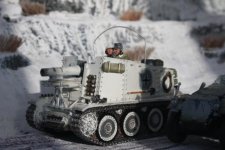
The grenadiers had suffered especially at the hands of the artillery concentration based there - initially to support the Hurtgen Forest attacks to the north
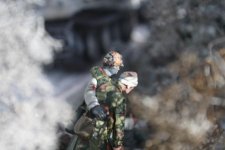
The commander studies his maps then surveyed the battlefield
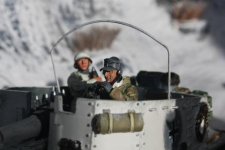
The infantry pulled back cautiously under the cover of the barrage behind them
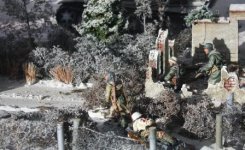
The loader of the heavy 150mm shells would be glad when they ran out of ammunition, it would not be long as the logistical support was at breaking point.......
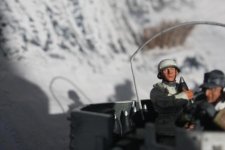
panda1gen
Colonel
- Joined
- Jul 29, 2005
- Messages
- 8,154
The German armoured forces experience some unusual logistical problems after they overun a US HQ and supply dump. Amongst the wonderful haul of chocolate, tinned peaches etc was some tobacco..........
Achtung, schnell, when are you going to fix my tank?
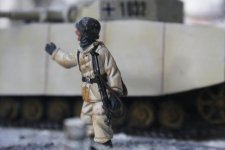
Chill dude, I still have a full pipe and I'm smoking hot?
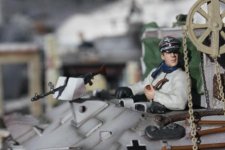
Achtung, schnell, when are you going to fix my tank?

Chill dude, I still have a full pipe and I'm smoking hot?

Currahee Chris
Sergeant Major
- Joined
- Apr 24, 2007
- Messages
- 4,776
A panzer grenadier wishes he was warm............
View attachment 49869
A jagdpanther driver wishes he had parking sensors when trying to back into a space
As McKenna says, keep it silly
This is easily one of my favorite pics of yours. This is also my favorite of your diodramas
panda1gen
Colonel
- Joined
- Jul 29, 2005
- Messages
- 8,154
panda1gen
Colonel
- Joined
- Jul 29, 2005
- Messages
- 8,154
Sixty six years ago today, the Germans were arguably already suffering defeat in the Battle of the Bulge.
On 16 December 1944, at 5:30 a.m., the Germans began the assault with a massive, 90-minute artillery barrage using 1,600 artillery pieces[44] across an 80 miles (130 km) front on the Allied troops facing the Sixth SS Panzer Army.
The Americans' initial impression was that this was the anticipated, localized counterattack resulting from the Allies' recent attack in the Wahlerscheid sector to the north where the 2nd Division had knocked a sizable dent into the Siegfried Line. In the northern sector Dietrich's Sixth SS Panzer Army assaulted Losheim Gap and Elsenborn Ridge in an effort to break through to Liège. Heavy snowstorms engulfed parts of the Ardennes area.
While having the desired effect of keeping the Allied aircraft grounded, the weather also proved troublesome for the Germans because poor road conditions hampered their advance. Poor traffic control led to massive traffic jams and fuel shortages in forward units.
In the center, von Manteuffel's Fifth Panzer Army attacked towards Bastogne and St. Vith, both road junctions of great strategic importance. In the south, Brandenberger's Seventh Army pushed towards Luxembourg in their efforts to secure the flank from Allied attacks. Only one month before 250 members of the Waffen-SS had unsuccessfully tried to recapture the town of Vianden with its castle from the Luxembourgish resistance during the Battle of Vianden.
The battle for Elsenborn Ridge was a decisive component of the Battle of the Bulge, deflecting the strongest armored units of the German advance.[45]
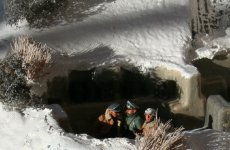
Peiper and his commanders
The attack was led by one of the best equipped divisions on the western front, 1st SS Panzer Division (LSSAH). The division made up the lead unit for the entire German 6th Panzer Army. Kampfgruppe Peiper of the LSSAH division was selected its spearhead to lead the main effort and was commanded by then SS Obersturmbannführer Joachim Peiper.[46]


Sepp Dietrich led the Sixth SS Panzer Army in the northernmost attack route.
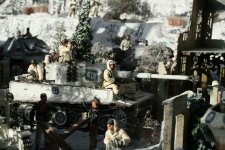
The attacks by the Sixth SS Panzer Army's infantry units in the north fared badly because of unexpectedly fierce resistance by the U.S. 2nd and 99th Infantry Divisions. On the first day, an entire German battalion of 500 men was held up for 10 hours at Lanzerath, which controlled a key route through the Losheim Gap.
To preserve the quantity of armor available, the infantry of the 9th Fallschirmjaeger Regiment, 3rd Fallschirmjaeger Division, had been ordered to clear the village first.
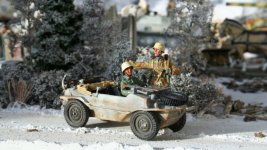
A single 18-man Intelligence and Reconnaissance Platoon from the 99th Infantry Division along with four Forward Air Controllers held up the battalion of about 500 German paratroopers until sunset, about 4:00 p.m, causing 92 casualties among the Germans.
This created a bottleneck in the German advance. Kampfgruppe Peiper, at the head of the SS Oberstgruppenführer Sepp Dietrich’s Sixth Panzer Army had been designated to take the Losheim-Losheimergraben road, but it was closed by two collapsed overpasses.[47]
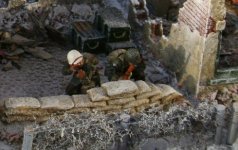
Once the Germans reached Bucholz Station, they quickly captured portions of the 3rd Battalion of the 394th Infantry Regiment. To Kampfgruppe Peiper's north, the 277th Volksgrenadier Division attempted to break through the defending line of the U.S. 99th Infantry Division and positions of 2nd Infantry Division. Their intention was to control the twin villages of Rocherath-Krinkelt which would clear a path to the high ground of Elsenborn ridge. Occupation of this dominating terrain would allow control of the roads to the south and west and ensure supply to Kampfgruppe Peiper's armored task force. The stiff American defense prevented the Germans from reaching the vast array of supplies near the cities of Liège and Spa, Belgium and the road network west of the Elsenborn Ridge leading to the Meuse River.[48]
Historian John S.D. Eisenhower wrote, "...the action of the 2nd and 99th Divisions on the northern shoulder could be considered the most decisive of the Ardennes campaign."[49]:224[50]
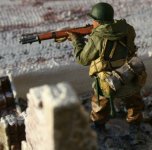
The 99th Infantry Division as a whole, outnumbered five to one, inflicted casualties in the ratio of eighteen to one. The division lost about 20% of its effective strength, including 465 killed and 2,524 evacuated due to wounds, injuries, fatigue, or trench foot. German losses were much higher. In the northern sector opposite the 99th, this included more than 4,000 deaths and the destruction of sixty tanks and big guns.[51]
On 16 December 1944, at 5:30 a.m., the Germans began the assault with a massive, 90-minute artillery barrage using 1,600 artillery pieces[44] across an 80 miles (130 km) front on the Allied troops facing the Sixth SS Panzer Army.
The Americans' initial impression was that this was the anticipated, localized counterattack resulting from the Allies' recent attack in the Wahlerscheid sector to the north where the 2nd Division had knocked a sizable dent into the Siegfried Line. In the northern sector Dietrich's Sixth SS Panzer Army assaulted Losheim Gap and Elsenborn Ridge in an effort to break through to Liège. Heavy snowstorms engulfed parts of the Ardennes area.
While having the desired effect of keeping the Allied aircraft grounded, the weather also proved troublesome for the Germans because poor road conditions hampered their advance. Poor traffic control led to massive traffic jams and fuel shortages in forward units.
In the center, von Manteuffel's Fifth Panzer Army attacked towards Bastogne and St. Vith, both road junctions of great strategic importance. In the south, Brandenberger's Seventh Army pushed towards Luxembourg in their efforts to secure the flank from Allied attacks. Only one month before 250 members of the Waffen-SS had unsuccessfully tried to recapture the town of Vianden with its castle from the Luxembourgish resistance during the Battle of Vianden.
The battle for Elsenborn Ridge was a decisive component of the Battle of the Bulge, deflecting the strongest armored units of the German advance.[45]

Peiper and his commanders
The attack was led by one of the best equipped divisions on the western front, 1st SS Panzer Division (LSSAH). The division made up the lead unit for the entire German 6th Panzer Army. Kampfgruppe Peiper of the LSSAH division was selected its spearhead to lead the main effort and was commanded by then SS Obersturmbannführer Joachim Peiper.[46]


Sepp Dietrich led the Sixth SS Panzer Army in the northernmost attack route.

The attacks by the Sixth SS Panzer Army's infantry units in the north fared badly because of unexpectedly fierce resistance by the U.S. 2nd and 99th Infantry Divisions. On the first day, an entire German battalion of 500 men was held up for 10 hours at Lanzerath, which controlled a key route through the Losheim Gap.
To preserve the quantity of armor available, the infantry of the 9th Fallschirmjaeger Regiment, 3rd Fallschirmjaeger Division, had been ordered to clear the village first.

A single 18-man Intelligence and Reconnaissance Platoon from the 99th Infantry Division along with four Forward Air Controllers held up the battalion of about 500 German paratroopers until sunset, about 4:00 p.m, causing 92 casualties among the Germans.
This created a bottleneck in the German advance. Kampfgruppe Peiper, at the head of the SS Oberstgruppenführer Sepp Dietrich’s Sixth Panzer Army had been designated to take the Losheim-Losheimergraben road, but it was closed by two collapsed overpasses.[47]

Once the Germans reached Bucholz Station, they quickly captured portions of the 3rd Battalion of the 394th Infantry Regiment. To Kampfgruppe Peiper's north, the 277th Volksgrenadier Division attempted to break through the defending line of the U.S. 99th Infantry Division and positions of 2nd Infantry Division. Their intention was to control the twin villages of Rocherath-Krinkelt which would clear a path to the high ground of Elsenborn ridge. Occupation of this dominating terrain would allow control of the roads to the south and west and ensure supply to Kampfgruppe Peiper's armored task force. The stiff American defense prevented the Germans from reaching the vast array of supplies near the cities of Liège and Spa, Belgium and the road network west of the Elsenborn Ridge leading to the Meuse River.[48]
Historian John S.D. Eisenhower wrote, "...the action of the 2nd and 99th Divisions on the northern shoulder could be considered the most decisive of the Ardennes campaign."[49]:224[50]

The 99th Infantry Division as a whole, outnumbered five to one, inflicted casualties in the ratio of eighteen to one. The division lost about 20% of its effective strength, including 465 killed and 2,524 evacuated due to wounds, injuries, fatigue, or trench foot. German losses were much higher. In the northern sector opposite the 99th, this included more than 4,000 deaths and the destruction of sixty tanks and big guns.[51]
panda1gen
Colonel
- Joined
- Jul 29, 2005
- Messages
- 8,154
Excellent pictures of the bergpanzer and panzer VI
Mitch
Thanks
Fighting goes on.................
Attachments
panda1gen
Colonel
- Joined
- Jul 29, 2005
- Messages
- 8,154
Kevin,
You and UK Reb are in a class by yourselves.
Is that real snow by the way? I was thinking of doing something like that but was wondering if that would harm the models.
Cheers,
Thanks Brad, compliments of the season.
Clive's shots were taken in the snow. I don't do that but tried to work it in on occassions. The last shot of the guy being shot was done on the old hill I made.
panda1gen
Colonel
- Joined
- Jul 29, 2005
- Messages
- 8,154
Nice set of figures
Mitch
Once again Kevin another round of excellent photos an story telling. Hope Santa was good to you an looking forward once again for the next round of story telling an photos. Happy New Year..........Joe
This is a great thread
Cheers
Martyn
Guys - Kind words, thank you and a happy 2011 to you all.
I enjoy your threads too Lt, we can't collect everything more is the pity so this is a great way of enjoying other periods and collections.
Martyn, I appreciate your support too, but I don't feel that I can compete with your superb boat and Victorian figures. I love the Nile boat and companions for example.
Anyway some interminable WW2 stuff..............
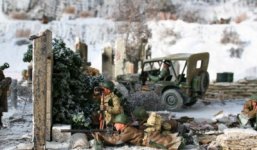
Advance elements of a US recon team set up a roadblock with a thirty calibre
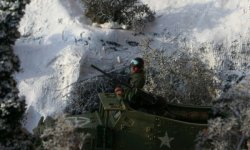
Meanwhile the White scout car attached to the MG team tries to find better cover
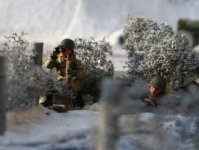
An observation post on a nearby ridge looks out
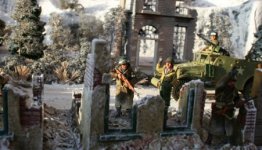
Other US troops search some ruins
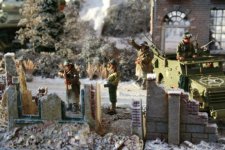
The MP's take control in anticipation of controlling the road network for 7th Armoured Divisions blocking move to St Vith
Users who are viewing this thread
Total: 3 (members: 0, guests: 3)



